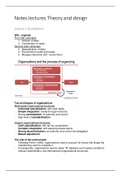Notes lectures Theory and design
Lecture 1 Foundations
Why organize
Firs order rationales
1. Division of labor
2. Coordination of tasks
Second-order rationales
3. Specialization of labor
4. Economies of scale and scope
5. Manage interaction with environment
Two archetypes of organizations
Mechanistic organizational structures
- Individual specialization: with clear tasks
- Simple integration: mainly through hierarchy
- Strong centralization: of authority and control
- High level of standardization
Organic organizational structures
- Joint specialization: with ad hoc coordination
- Complex integration: with special purpose teams
- Strong decentralization: as authority and control are delegated
- Mutual adjustment
The role of the environment
- Following Porter (1980), organizations need to account for forces that shape the
markets they want to compete in
- Consequently, organizations need to attain “fit” between such market conditions,
relevant stakeholders, and international organizational structures.
,Everyone has theories
From concepts to theories
- A theory is a system of statements targeted at describing, explaining, and
predicting a real world phenomenon (Bacharach 1989).
• Statements consist of constructs and propositions (i.e., relationships
between constructs).
• Collectively, this system presents a logical, systematic, and coherent
explanation of the real-world phenomenon within certain boundaries
Theory
Put formally
Boundary = assumption about values, time and space
Organizational Design
,Lecture 2
Challenges in collective value generation
- Control
- Integrate
- Motivate
This three things you can do in two types of organizations:
• Formal organization (structure)
• Informal organization (culture)
This two are related to each other
The grandfather of organizational theory
- Max Weber (1864-1920)
Weber’s bureaucracy in action
If we adopt these principles, our organization should run like a well-oiled machine.
, - Interactions between organizational levels will be efficiently regulated
- Each person will know his/her role in the organization
- Explicit rewards/punishments reduce the costs of enforcing and assessing
employee behavior
- Because each position is independent from the person, promotion is a motivation
force.
But bureaucracy also generates costs
- If we fail to control the development of hierarchy, the organization will grow very
large and inefficient (Parkinson’s Law), rendering decision making very slow.
- Members may rely too much on rules and standard operating procedures to make
decisions, which makes them unresponsive to the needs of customers and other
stakeholders.
Benefit of direct supervision
- Control
• Continually question and probe subordinates
• Direct observation and evaluation/training
• Prevent free-riding
- Integrate
• Continuous task-assignment
• Managing relations between multiple subordinates
- Motivates
• Mentoring and professional development
• Immediate feedback and performance-based reward
Design choices in vertical differentiation
On the right the managers have a lot more time to motivate and control their
employees.
Important design principles
1. Limits in managers’ span of control
Pick optimal number of subordinates to supervise by a single manager,
depending on:
- More complexity of subordinates’ tasks, smaller span of control
- More interrelatedness of subordinates’ tasks, smaller span of control
Design choices in vertical differentiation





